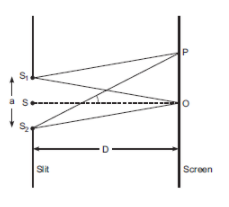
Use Huygens principle to explain the formation of diffraction patterns due to a single shit illuminated by a monochromatic source at light. When the width of the shit is made double the original width, how would this affect the size and intensity of the central diffraction band?
Answer
488.7k+ views
Hint: Use the concept of Huygens’s principle.
Use the young slit experiment for this problem.
Complete step by step solution:
According to the Huygen's principle "The net effect at any point due to the number of wavelets is equals to sum total contribution at all wavelets with proper phase difference

The point N is Maxima because from each part of the slit S1 RS2 is in phase means the path difference is O.
At point M
(i) If \[{{S}_{2}}i-{{S}_{1}}i=n\lambda \] then point p would be minimum
(ii) If \[{{S}_{2}}P-{{S}_{1}}P=\left( 2n+1 \right)\dfrac{\lambda }{2}\] then point P would be Maxima. At the point of Maxima, intensity will decrease.
The width of the central Maxima is given by \[\dfrac{S\lambda D}{a}\]
Where
\[\lambda =\]Wavelength
\[D=\] Distance between screen and the slit
\[a=\] Size of the slit
When the width of the slit is made double the original width then the size of the central maxima will be reduced to half and intensity will be four times.
Note: Student should be better understanding of Huygens’s principle. The young slit experiment observes carefully. The width of the slit makes a huge impact on calculations.
Use the young slit experiment for this problem.
Complete step by step solution:
According to the Huygen's principle "The net effect at any point due to the number of wavelets is equals to sum total contribution at all wavelets with proper phase difference

The point N is Maxima because from each part of the slit S1 RS2 is in phase means the path difference is O.
At point M
(i) If \[{{S}_{2}}i-{{S}_{1}}i=n\lambda \] then point p would be minimum
(ii) If \[{{S}_{2}}P-{{S}_{1}}P=\left( 2n+1 \right)\dfrac{\lambda }{2}\] then point P would be Maxima. At the point of Maxima, intensity will decrease.
The width of the central Maxima is given by \[\dfrac{S\lambda D}{a}\]
Where
\[\lambda =\]Wavelength
\[D=\] Distance between screen and the slit
\[a=\] Size of the slit
When the width of the slit is made double the original width then the size of the central maxima will be reduced to half and intensity will be four times.
Note: Student should be better understanding of Huygens’s principle. The young slit experiment observes carefully. The width of the slit makes a huge impact on calculations.
Recently Updated Pages
The correct geometry and hybridization for XeF4 are class 11 chemistry CBSE

Water softening by Clarks process uses ACalcium bicarbonate class 11 chemistry CBSE

With reference to graphite and diamond which of the class 11 chemistry CBSE

A certain household has consumed 250 units of energy class 11 physics CBSE

The lightest metal known is A beryllium B lithium C class 11 chemistry CBSE

What is the formula mass of the iodine molecule class 11 chemistry CBSE

Trending doubts
State the laws of reflection of light

One Metric ton is equal to kg A 10000 B 1000 C 100 class 11 physics CBSE

Difference Between Prokaryotic Cells and Eukaryotic Cells

What is the modal class for the following table given class 11 maths CBSE

How do I convert ms to kmh Give an example class 11 physics CBSE

Give an example of a solid solution in which the solute class 11 chemistry CBSE




